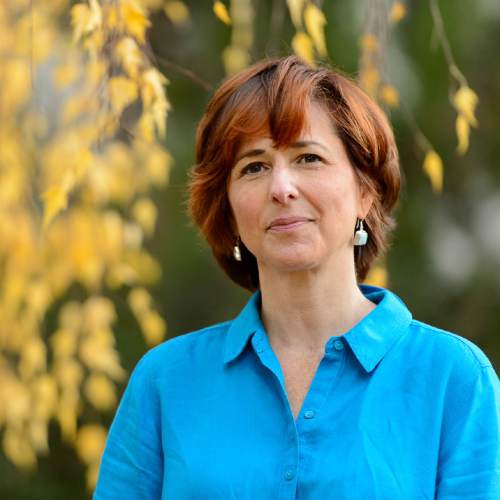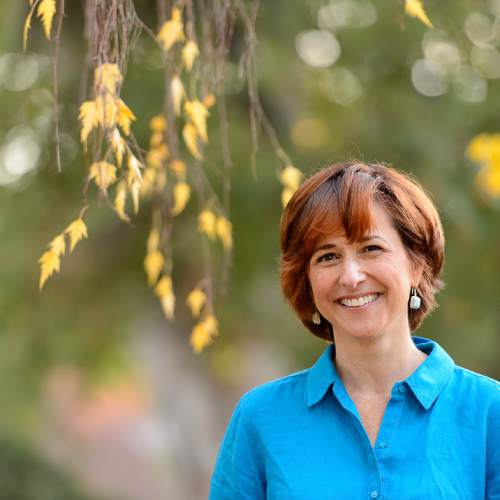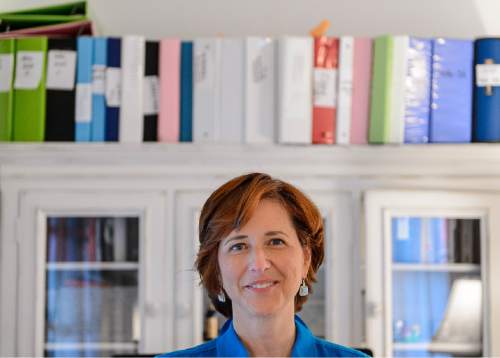This is an archived article that was published on sltrib.com in 2015, and information in the article may be outdated. It is provided only for personal research purposes and may not be reprinted.
Julie Checkoway happened to be working at The Salt Lake Tribune when she heard the story of a Maui swim club formed in the 1930s. The details were intriguing — it was a club for Japanese-American kids who lived in ticky-tacky company houses on a sugar plantation and who learned to swim in the plantation's irrigation ditches. It was a club where the kids were dirt poor, too poor to afford swimsuits, without even a single towel to share among them.
Their unschooled coach might have seemed impossibly ambitious. And yet, remarkably and against all odds, and after the international trauma of World War II, a club member went on to win gold in the 1948 London Olympics.
The details of Maui's Three-Year Swim Club seemed almost too good to be true to Checkoway, especially when she realized the complete story had never really been told. Coach Sochi Sakamoto, who launched the club to inspire his ragtag kids with Olympic dreams, was an oddball, something of a loner, a fifth-grade science teacher who not only couldn't swim, he simply didn't know much of anything about coaching swimming.
He called his swimmers the Three-Year Swim Club because he wanted them to aim at the impossible, the 1940 Olympics, which would later be canceled due to the outbreak of World War II.
—
'Buzz' book • The prospect of telling the story of the Maui swim club inspired Checkoway to quit her Tribune reporting job in 2008 to write a book proposal. The project was stalled for a time as she pursued other projects, in part because of concerns that she wouldn't be able to get access to enough documents and enough people who would help her piece together the club's history.
Her research started and stopped again. Through the years, she would come to puzzle over the personality of Sakamoto, the central, complicated character in her book, "The Three-Year Swim Club: The Untold Story of Maui's Sugar Ditch Kids and Their Quest for Olympic Glory."
Checkoway's book — which will be launched at a release party Tuesday at The King's English in Salt Lake City — is considered one of the publishing world's "buzz" books of the fall season.
According to Publishers Weekly, Grand Central Publishing will release 200,000 copies in its first printing. That's only 50,000 fewer than the 250,000 copies that St. Martin's Press published in the first printing of Elizabeth Smart's "My Story" in 2013.
—
'Triumph of underdogs' • "I would love it to sell jillions of copies because I think it's an important book," says Checkoway's editor, Deb Futter, vice president and editor in chief at Grand Central.
"There's the history angle, there's the racism angle, there's the athletics angle, and what I think is the most resonant angle, the story of inspiration, about swimmers who were able to conquer and overcome in an area where nobody thought they could," Futter says.
She hopes "The Three Year Swim Club" will have the impact of Daniel James Brown's 2013 best-seller "The Boys in the Boat," about the 1936 U.S. men's Olympic eight-oar rowing team. Both books are inspiring stories with historical over- and undertones, Futter says.
The editor praises the depth and breadth of Checkoway's research, her filmmaker's eye and her insightful writing. "How can you not have a tear in your eye at the end?" she says. "It's a good yarn, well told."
"A brightly told story of the triumph of underdogs," is how Kirkus Reviews summarizes the book.
Checkoway, a Massachusetts native, graduated from Harvard and studied fiction writing at the Iowa Writers' Workshop. She's the author of 1996's "Little Sister: Searching for the Shadow World of Chinese Women," the editor of 2001's "Creating Fiction" and a former creative-writing professor at the University of Houston.
She has reported and produced radio stories for NPR and "This American Life," and her 2008 documentary about obsessive artist Billy Pappas, "Waiting for Hockney," screened at Tribeca and other film festivals.
Checkoway and her husband, Lee Thomsen, Rowland Hall Upper School principal, have two daughters and live in Salt Lake City.
In "The Three-Year Swim Club," local readers will catch glimpses of the influence of The Church of Jesus Christ of Latter-day Saints in Hawaiian history and will understand more about Utah's Japanese-American community through events of the book.
Checkoway carefully weaves together facts into a sweeping historical tapestry. She focuses on a handful of the earliest swimmers from Sakamoto's team — Kiyoshi "Keo" Nakama, Takashi "Halo" Hirose and some of the girls, including Fujiko Katsutani — then a later addition, a Hawaiian boy from a Mormon family, Bill Smith.
In addition, she explains other chapters in the story, including the history of Japanese immigration to Hawaii, the growth of Hawaiian tourism and sugar plantations, Tokyo officials' pursuit of the ill-fated 1940 Olympics Games, and the iconic figure of Hawaiian swimmer Duke Kahanamoku.
—
A glorious American amateur • Shadowing all the chapters is Sakamoto, whom Checkoway refers to as "brazen" in all the best of ways.
"I was overwhelmed throughout the process because I would constantly reach a new level of amazement of what he had invented," she says. "I just found myself gobsmacked every day when I had to write about technique, about the machines, about all of his innovations."
Checkoway labels Sakamoto a glorious American amateur, the kind of iconic figure who, against all odds, relies on grit and invention to make something happen. "In each amateur lives a mule-headed stubbornness and a remarkable flexibility, a firmness of spirit and a joie de vivre, a determination matched equally by a fine appreciation of the surprising and the serendipitous," she writes in a book club guide.
Drawing upon his intuition, Sakamoto invented swim training techniques that are routinely applied today, but were unheard of at the time, including teaching his kids to swim upstream against the current — "like salmon," he explained to them, although none of his kids knew what a salmon was — in plantation ditches. Other innovations included stroke analysis, interval training, dry-land exercises, fast-slow progressions, using kickboards and pulley weight machines made from junk.
"Sakamoto was by nature quiet, humble, enigmatic and profoundly distant from others," says Checkoway, adding that his swimmers respected him and listened to him but didn't really know him. Neither did his family. "I was amazed that, in the course of researching this book, so many of the club members were learning the details of Sakamoto's life as I was."
—
'A fractured three-act play' • Checkoway refers to the triangulation she used in her research, as she would often draw upon anywhere from three to 15 sources to attempt to pin down the truth of incidents that might have morphed into legend. She worked to match newspaper and magazine accounts of contemporary events with photographs and letters and transcripts of interviews.
There was a puzzle, for example, in figuring out the club's timeline, which she came to learn began about five years after Sakamoto had volunteered to supervise kids splashing around in the sugar plantation's irrigation ditch. "Babysitting," he called it at the time. Some swimmers said the club was founded in 1936, while others remembered it starting in 1937. "One of the most satisfying moments in my research was when, after puzzling over this problem for months, I calculated the date and time to the minute: at noon on Monday, June 7, 1937," Checkoway says. "I will never forget that little eureka. Surely no one in the world could care about it as much as I did, but it was a quiet, sweet moment of 'aha' when I figured it out."
She considered the structure of the book a "fractured three-act play." Sakamoto didn't achieve his original vision for his swimmers to make it to the Olympics in three years. History and a world war intervened.
"Sakamoto's construction had to give way to the messiness and darkness of the then-new contemporary 20th-century reality," Checkoway says. "I like to think that the book I've written is messy in structure in part because the events themselves were a mess and that the heroic figures of the book are nearly unrecognizable, being modern heroes instead of classical ones: They're imperfect; they arrive late on the scene; they miss their cues; they bump into walls; they peak too early or too late. Stuff happens."
—
The work of 'steady-steady' • Up until recently, drafts of Checkoway's book concluded with scenes of Smith and Sakamoto embracing after the 400-meter Olympic race. Yet the writer felt that the scene, although inspirational, didn't do enough work explaining everything the swimmers had come to achieve in their lives, from serving in the military to becoming teachers like their coach.
Then messy stuff came to happen in Checkoway's personal life, namely a concussion that slowed progress in the final edits of the book. And that's when she stumbled upon another ending. She focused on a night 13 years later, when one of the earliest and best club swimmers, Keo Nakama, then 40 years old, launched a solo swim across the 27-mile-long Kaiwi Channel.
"It's about having gone for the gold and having done so much more," the writer says, summarizing the breadth of the Three-Year Swim Club story. "It's about the marathon and the long-distance swims that all those kids took. I knew the triumph was within the everyday living."
No matter what happens to the book now, no matter how many readers find it, Checkoway is thrilled to have shipped copies to the handful of Sakamoto's still-living swimmers and their families.
"I feel like I was writing it as much for them as for anybody," she says. "It's a great American story, and to bring this story into the record for the swimmers and their families gives me no end of pleasure."
One of the key elements of Sakamoto's training was encouraging his swimmers to think "steady-steady," advice he had gleaned from best fieldworkers on the sugar plantation. "I had never written a book of this scope and breadth before," Checkoway says. "I was afraid I couldn't do it. But 'steady-steady' became my mantra, and I reminded myself of Sakamoto's principle every single day of the project."
facebook.com/ellen.weist —
Julie Checkoway reading
Former Tribune feature writer Julie Checkoway will launch her new book, "The Three-Year Swim Club," which boasts an impossibly epic subtitle: "The Untold Story of Maui's Sugar Ditch Kids and Their Quest for Olympic Glory."
When • Tuesday, Oct. 27, 7 p.m.
Where • The King's English Bookshop, 1511 E. 1500 South, Salt Lake City; free















